Our Favorite Moments of 2024
Marah Fielden
Director of Community Greening Projects
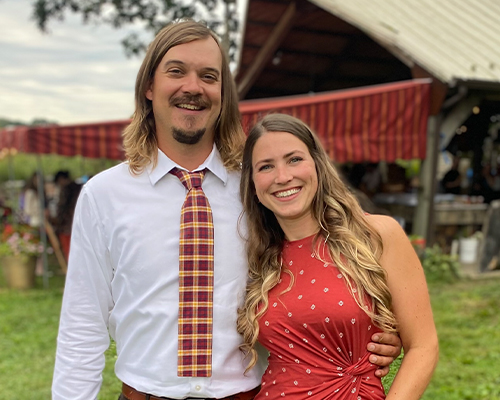
During the spring planting season of 2024, I took my two-year old twins to their first WPC community flower garden planting. It was a typical day of work for me where I came prepared with extra supplies and planting power to help the dedicated volunteers with their inaugural planting. I was at the community flower garden in Oil City, which has been brightening the gateway of this town for over 20 years. One of my favorite garden stewards, Rosalyn, was there running the show and was delighted to see me show up with two extra sets of little hands to help.
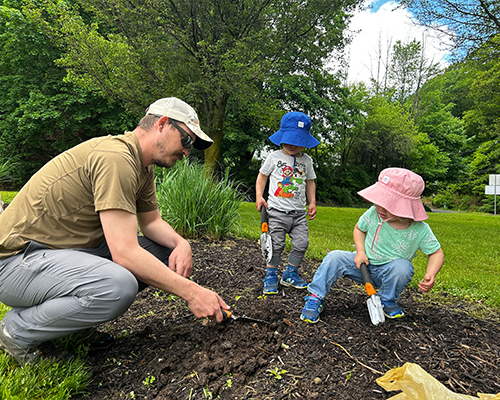
The twins had a great time playing in the dirt, and it was wonderful to watch them find worms and even manage to get a few flowers in the ground. This was my favorite moment because I got to experience what I have been helping to facilitate for other families for years – getting their kids outside and experiencing new activities in the natural world. We can’t wait to do it again next year!
Ryan Miller
Zoologist, Pennsylvania Natural Heritage Program
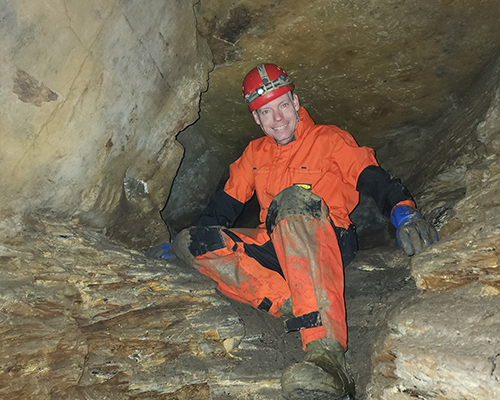
Last February we were asked to investigate a “cave” (actually an old iron-ore mine) for the presence of bats just outside of Pittsburgh in Allegheny County. I understand they’re not everyone’s favorite creature but they serve extremely important ecological roles and have been facing unprecedented population declines from White Nose Syndrome, a deadly fungal disease.
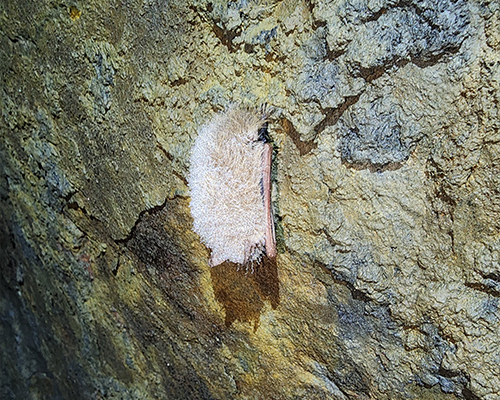
Some species have experienced a 98% population decline since 2011. During the survey, we squeezed in through a small opening and belly-crawled through inches of muck and mud, but once inside, it was roomy and warmer than the outside. We traversed the 200-foot mine and were elated to find a lone Tri-Colored Bat, an endangered species! It seemed healthy and hibernating well with a coating of dew drops covering its fur (which is normal for bats hibernating in warm, moist environments). We were careful not to disturb it. We are currently working on plans to secure the entrance to the mine (to keep the bats from being disturbed by adventurous people) and hopefully see more bats at this location in future surveys!
Katie Frick
AmeriCorps Land Steward
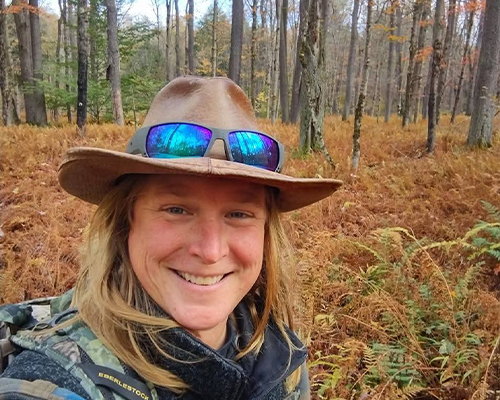
My role as a land steward with WPC started in November and although it was late in the year, I had the opportunity to explore and familiarize myself with several of the WPC preserves. While I appreciate the beauty and uniqueness of each property, there is one that holds a special place in my heart: the Babcock Family Nature Reserve in Keating Township, McKean County.
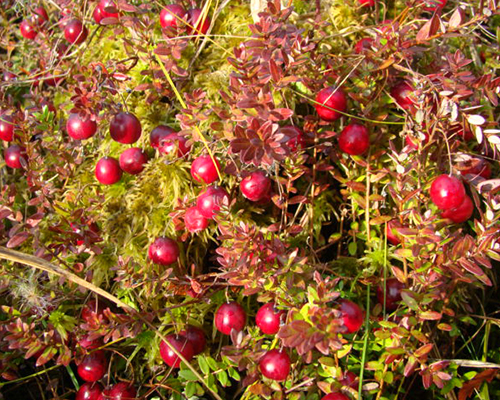
This property was acquired by WPC in 2023 but I have been exploring, hunting, and enjoying it since 2004! The wetland property features hemlock forests, shrub thickets, beaver ponds and a large sphagnum moss bog. The sphagnum moss bog provides a unique habitat for a variety of plants that like acidic living conditions, such as the wild cranberry (Vaccinium oxycoccos). Cranberries ripen in the fall. There is something mythical and ethereal about standing in a sphagnum moss bog in the fall, surrounded by cotton grass blowing in the wind, and seeing the bright red wild cranberries nestled in the sphagnum hummocks. I am thrilled and thankful to know that this unique and diverse property that I have enjoyed for many years will now be permanently protected through the efforts of WPC.
Luke Bobnar
Watershed Projects Manager, Upper Allegheny & Lake Erie
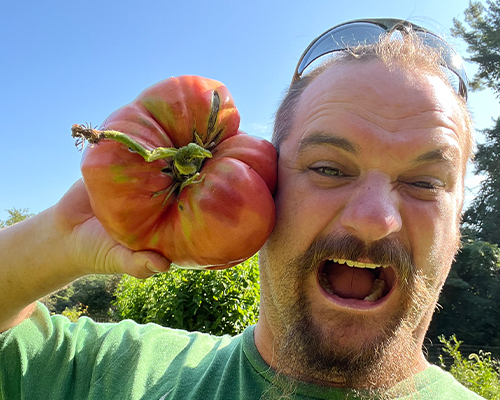
monster tomato
My favorite moment of 2024 was an interaction I had with a township supervisor. We’re working with that township to replace a failing culvert that is an aquatic organism passage barrier. While discussing that project, he mentioned some of the headaches he faces with environmentally sensitive road and culvert/bridge maintenance.
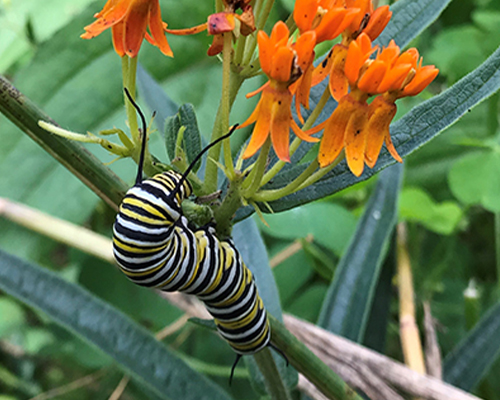
He said one of his last bridge inspection reports recommended that he “cut down the weeds on the roadside near the bridge approach.” He was in disbelief at the recommendation, as those ‘weeds’ were milkweeds, and there were monarch butterflies flying around them. He’d recently seen a nature documentary on the Monarch’s migrations, and was astounded and impressed by their long international journeys. He said “HELL NO! I ain’t mowin’ those weeds! There’s caterpillars spawnin’ down there!”
In this beautifully straightforward vernacular, he condensed the feelings many of us have about our work, as well as the drive to be good stewards of our landscape. No matter our occupation, we can still consider the environmental impacts our actions will have, and try to leave this place better for everyone. And you never know, maybe some of those caterpillars hatched down in our milkweeds will bring a smile to someone in another country!
Asia Young
Pittsburgh Office Front Desk Administrator

Asia Young, and Amanda Pavlowsky
Last October we had our annual staff event at Laurel Hill State Park in the Laurel Highlands.
It was such a fantastic time. We played games then hiked to a hilltop for the scenic view, take pictures and have dessert. I am looking forward to this year’s annual staff event!
Scott Schuette
Botany Program Manager, Pennsylvania Natural Heritage Program
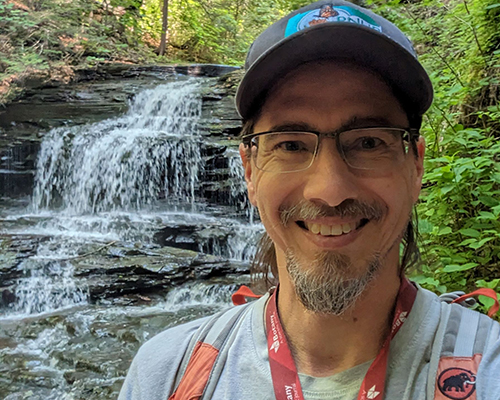
A collaborative project with U.S. Army Corps of Engineers, U.S. Geological Survey, and U.S. Forest Service brought a team of scientists from all over the country to map and characterize plant communities on the islands of the Allegheny River between Tidioute and West Hickory.
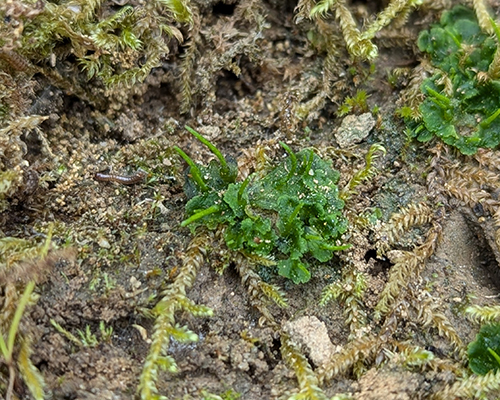
global conservation concern
During this amazing week of working from kayaks, I finally found all three species of hornworts known from Pennsylvania growing on the exposed sandy soils of riverbanks. These small, ancient plants specialize in early successional habitats and I usually find one species here or there in places like Erie Bluffs State Park, but this was the first time seeing all three of them in one area. Because of their ecology, these plants are quite ephemeral and are only visible at certain times of the year.
Among these three species, one is considered of global conservation concern, and when I found it in a back channel of one the islands it was the first time I had ever seen this species and it made my time on the river even more special. This kind of discovery helps inform both state and national efforts in bryophyte conservation by updating the known distributions of these often-overlooked plants and raises the profile of WPC involvement in a national movement of raising awareness for bryophyte conservation.
Rod Cross
Fallingwater Educator
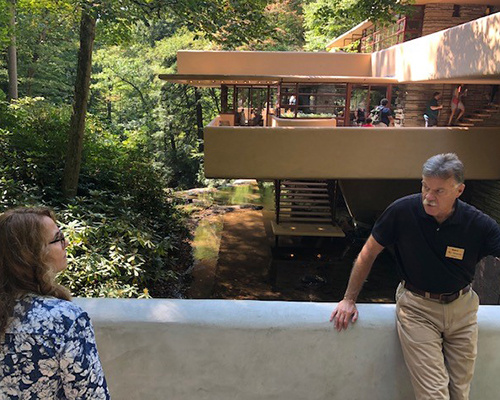
When we go out to greet our tours, we ask where folks are from. It could be Boston, Seattle or New Zealand! Lead Educator Paul Davis reported that we hosted visitors from 119 countries in 2024. Now I not only want my guests to experience Fallingwater, I also want our international visitors to have a positive experience with America. I know that this begins at the Gatehouse check-in and is extended to them throughout the tour that they have travelled so far to have.
That brief time we have with them is a snapshot of time when we all have one thing in common, to learn about the family, the architect and the house built over a waterfall in Mill Run, Pa.
Jennifer Sumoske
Communications Specialist
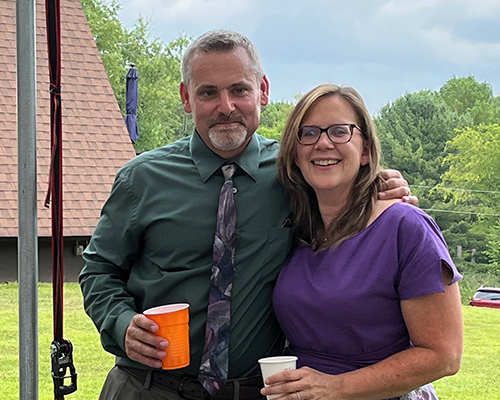
The best part of my job is talking with donors, volunteers and staff about their work and passion for conservation and then sharing their stories to inspire others. Usually, their stories end up inspiring me too.
For an article for our Perspectives newsletter, I spoke with Margie Forbes, who had made a donation to WPC in honor of her husband, Tom, who had recently passed away. Shortly after Tom’s death, Margie picked up the book “Eager; The Surprising, Secret Life of Beavers and Why they Matter,” by Ben Goldfarb and found comfort in its pages.

“I was intrigued by how beavers make everything better for other species,” Margie says. “I was reminded so much of Tom…he loved the outdoors, and was a happy and competent helper to everyone.”
Margie spoke so lovingly of Tom, which touched me deeply. And she was so excited about beavers that she inspired me to learn more about “nature’s engineers!”
One rainy Saturday afternoon 10 months later, for an article I was writing for Winter Conserve, I spoke with young Miles Moehle about his adventures designing a home for Wiby Throttletinker, a gnome living under a mushroom at Fallingwater. He shared his drawings, told jokes and described how impossible the project seemed and how his family rallied to help him succeed.
On a dark day during a rather difficult time, Miles’ off-the-rails enthusiasm and joy delivered me a huge ray of sunshine.
Hannah Huber
Conservation Mycologist, Pennsylvania Natural Heritage Program
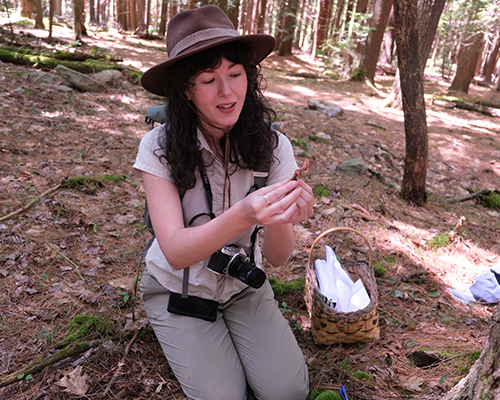
“What does this smell like to you?” I asked, offering a small, dusty rose-colored mushroom. It was late June and we – PNHP staff that work out of the Harrisburg office - were at Raymond B. Winter State Park in a hemlock-pine forest observing fungal characteristics involved in identification. The park’s Environmental Education Specialist Rebecca Harner also joined us. I wanted to shatter any preconceived notions of the “mushroomy” scent and also highlight the importance of scent in identification.

D. Cheyenne Moore, who coordinates rare plant conservation, took a whiff of the mushroom and thought seriously before answering “It smells like a child who’s just had pancakes and is drawing a picture with crayons.”
Cheyenne had understood the assignment, perceiving the sweetness and interpreting the rich, something else-ness of the mushroom, and I was proud.
The mushroom in question is commonly referred to as the “curry milkcap,” a more concise but also apt description. “Milkcap” refers to the liquid exuded when the gills are cut, a genus characteristic.
Michelle Ott
Fallingwater Educator
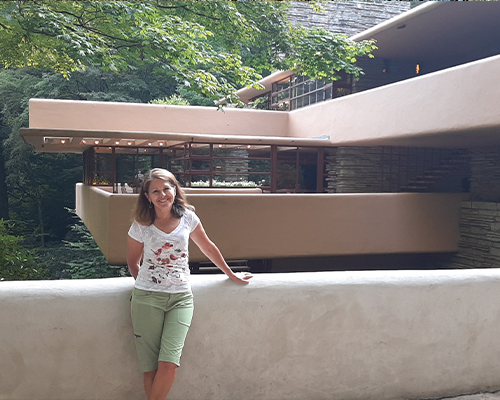
While leading a tour at Fallingwater last June, I overheard a conversation between a husband and wife in the living room that really piqued my curiosity. It turned out that this man had visited Fallingwater in the early 1980s as a college student. His professor was Edgar Kaufmann jr., who was then a visiting professor at Cornell University. I was fascinated to learn that Edgar jr. had brought his entire class to Fallingwater. Edgar's first presentation of the house to his students was at night from the bridge with all the lights on. The next day they were given a tour of the house and then allowed to wander around while Edgar jr. sat in the living room and talked with them. I wonder if those young students realized what a fantastic experience they were given. And how many other visitors have had personal connections with Edgar jr. that we never get the opportunity to hear about?
Eric Chapman
Director of Aquatic Sciences
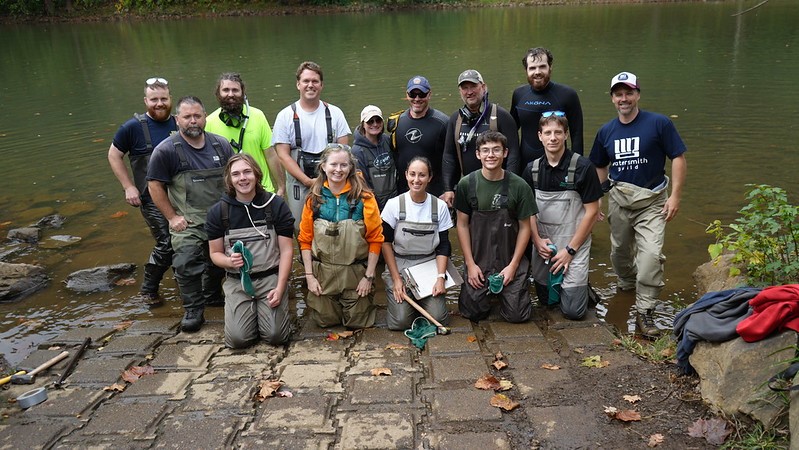
Kiski River. Eric is in the back row, second from the right.
Photo courtesy of the Watersmith Guild.
During October, I had a profound moment in my 20+ year career -- the stocking of the first hatchery-reared freshwater mussels in the Kiskiminetas (Kiski) River with numerous project partners…all of whom had smiles on their faces despite water temperatures in the mid 50s. Staff from the Pennsylvania Fish and Boat Commission and WPC, and volunteers from the Watersmith Guild, a nonprofit that works to inspire watershed conservation through arts and adventure, donned wetsuits and chest waders to handplace three species of two-year-old freshwater mussels into the river bottom.
The Kiski River has seen an incredible increase in aquatic diversity, with 12 species of mussels now found in this recovering river. This improvement is due in large part to the numerous grassroots watershed groups and county conservation districts that have been working to reduce the harmful impacts of acid mine drainage for several decades. With over 2,000 mussels planted in the Kiski River in 2024, water quality will continue to improve, and local residents, as well as visiting paddlers, can continue to enjoy this amazing river.
Thank you to all of our supporters who have made these moments possible!
